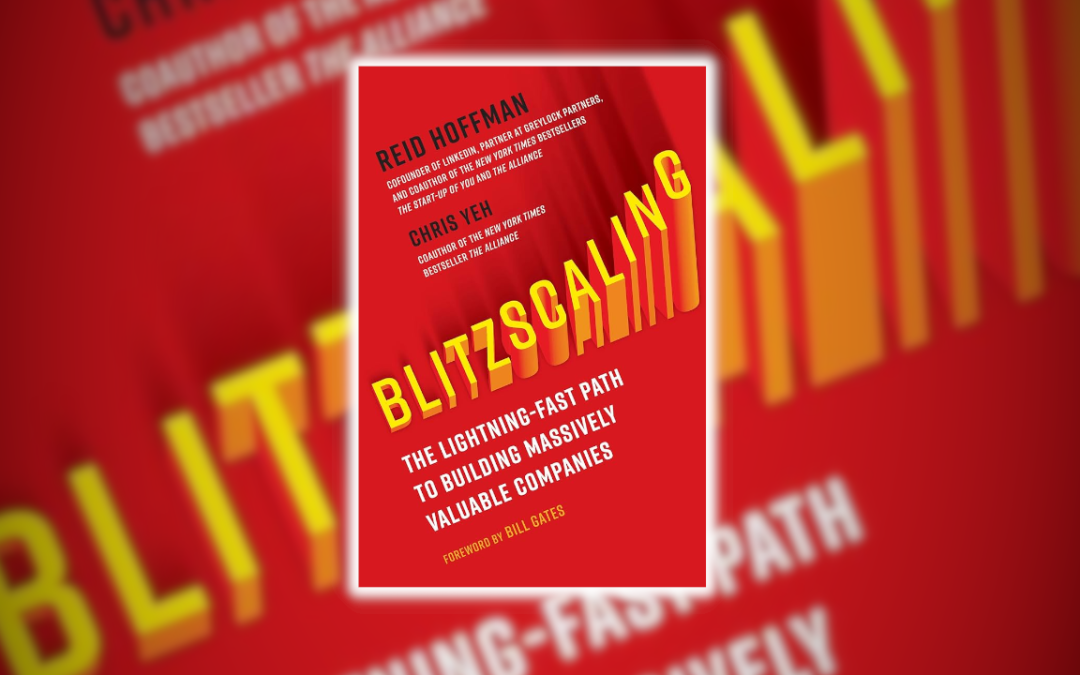Believe it or not, 90 percent of startups fail, 70 percent shutting down within the first five years. More often than not, they just do not grow fast enough to ensure investors maintain…. their confidence in the venture. And with VC capital being the lifeblood of the startup scene, growth at any cost is the goal. That is how you build a billion dollar business in the startup world. So it is no wonder we see entire books written on the subject. If you could only read one, I would strongly suggest Blitzscaling, which not only sets out a blueprint for growth, but coins a term for rapid corporate growth.
Thus, the purpose of this book is not primarily aimed at those wishing to establish a small service brand or a local brick and mortar store. It’s the people looking to build unicorns – startups with a valuation of at least a billion dollars – in an accellerated time frame.
It’s a topic the authors has a great deal of knowledge about, Reid Hoffman being the primary writer. You may have heard that name before. Hoffman is a co-founder of LinkedIn, the major social media platform aimed at business people. LinkedIn today has more than a billion registered users, and in 2016 Microsoft bought it for 26.2 billion dollars. Now he has joied forces with the author Chris Yeh to share what he has learned along the way.
His Main Points Of Advice
1: Embrace Risk
At the heart of every great business is a spark of bold originality. Starting a business is always a risk, but the businesses that experience rapid growth tend to take the biggest of risks. After all, if it were obvious, someone else would have taken your business idea beforehand. It’s by going after the new, revolutionary business ideas that blitzscaling is possible. In order to get the first movers advantage, you have to actually be the first mover in a space. And it goes beyond mere business ideas. You must risk expanding too quickly, a problem that’s proven fatal to countless businesses. Blitzscaling required serious investment. It’s truly an all or nothing strategy. So if you find yourself unable to truly embrace risk, maybe this kind of growth just isn’t for you. Be bold.
2: Networks Are A Cheat Code
Network Effect is a common buzzword in silicon valley. But unlike most buzzwords, there is a solid concept behind it. Essentially it’s just the idea that the strength of a network increases with it’s number of users. Market places like Etsy eBay are prime examples. The more people are on it selling products, the more people will sign up to search for products. This in turn raises the profile of the network as a whole, attracting more sellers and buyers alike. And there are multiple kinds of network. Social media sites like Facebook and Instagram, for example. That’s why we call them social networks. The only limit to how one can use networks are the limits in human creativity.
3: Distribution Is Key
Among the most important factors detailed in the book is distribution. Be it digital or physical, your product will need some form of distribution. Many entrepreneurs spend the bulk of their time and energy thinking about creating the perfect product, just to neglect the question of how to best get said product into the hands of their clients. As such, they struggle in the months and years after launch. Resist this by taking it into consideration from the get go. Reid Hoffman recommends two methods of addressing the issue.
The first is to latch onto pre-existing distribution networks. This can be done by partnering with companies that already deliver to customers – think Amazon or UPS. The second is to incentivize client referrals. In other words you offer customers a discount or some kind of prize for spreading the word. If they convince a friend or relative to sign up for your service, the prize has earned you a new subscriber. Some software firms even offer a share of the fee paid by their referee. That’s quite the incentive.
4: High Margins Only
Stack em high sell em cheap. That is the motto associated with retail. But while there are multiple billion dollar retail empires across the world, a different pricing strategy is recommended for new startups. Explosive growth is expensive. In order to realistically achieve it, what you need is high margins. That way you’ll have a healthy amount of money to reinvest into the business. It is always tempting to undercut the competition, but doing so can come at the expense of long term progress.
Remember that the startup experience is a race. Become profitable or go public before your investors lose faith, or it’s game over. Under conditions as such, bigger margins are a must. Generally speaking, 40% is the minimum number for startups to be taken seriously. Any less and the community will consider your project dead in the water. In the vast majority of business sectors, 30% is on the higher end of profit margins. So it says a lot about startups that 40% is on the lower side.
5: Seek out Patterns
Remember that you are not the first person to found a business, that your startup is not the first to walk the long path to success. And so there are certain observable patterns that have emerged. Things successful businesses do that others do not. To take advantage of such patterns just pay attention to what strategies successful unicorns have done. To the decisions that actually yield results.
One of the more powerful of patterns involves building platforms. Properly constructed and marketed, significant new income streams can be created, almost from thin air. Take iTunes for example. Each sale made via iTunes earns Apple a royalty payment, just from owning the platform itself. Fiverr is another fine example. Their platform connects freelance workers to potential customers. In keeping with the platform business model, they get a cut of each transaction. And this is just one of the multiple proven strategies waiting to be discovered in Blitzscaling.
6: Have A Long Term Plan
Startup or not, every business needs a long term plan. Even giants of industry like Facebook and Uber cannot keep up the explosive growth of their early years. It’s just not realistic. Blitzscaling is just one stage in the life of a startup, and it would be wise to prepare for when that stage ends. Growing a business is never easy. But the larger it grows, the more complex of a task that is.
It’s a question of math. More employees and more customers means more to be managed. Mo money mo problems, to quote a great man. Reflecting this reality, management strategy is fundamental to your long term plan. You also need to make sure you have a strategy for becoming profitable. All the growth in the world means nothing if you can’t at some point turn a profit. I can’t go into much detail, but there are numerous case studies in the book of unicorns who struggled through this process at one point or another.
My Thoughts
Those are just six lessons from a book full of them. I think the best part of the book by far are the individual models and tips found within each chapter. A clear set of instructions you will find actionable.
But at the heart of Blitzscaling is the concept of the feedback loop. A startup that grows rapidly can get ahead of the competition, which in term leads to market dominance and higher revenues. If profit margins are sufficiently high, the fruits of your labor can then be reinvested, virtually guaranteeing more growth. And if you plan on taking advantage of said feedback loop, there could be nothing better to help you along the way than a book like Blitzscaling. Perhaps it will even tell you how to build a billion dollar business.
But remember that explosive growth can sometimes be like Frankenstein’s Monster. Once you get the ball rolling it can be difficult to control. I think of it like a fast car. Driving faster than others can indeed win you the race. But go too fast and you will lose control. Lose control of a startup during the Blitzscaling phase and all your hard work may be for nothing.
Would I Recommend?
Only a successful business leader like Reid Hoffman could have written this book. The detail and pure depth have clearly been drawn from a wealth of experience actually building startups. That in my view will always be preferable to a book based only on theory. Without a doubt I recommend this book.

